![]()
How to Plug in 50-amp Service into a 30-amp Outlet?
DISCLAIMER: AS AN AMAZON ASSOCIATE I EARN FROM QUALIFYING PURCHASES. THIS POST CONTAINS AFFILIATE LINKS THAT WILL REWARD ME MONETARILY OR OTHERWISE WHEN YOU USE THEM TO MAKE QUALIFYING PURCHASES. FOR MORE INFORMATION, PLEASE READ MY EARNINGS DISCLAIMER.
|
(50+50) x 120 volts = 12,000 watts
And 30-amp service offers only 1 hot wire @120-volts:
30-amps x 120-volts = 3,600 watts
This means that you will have only 3,600 watts to work with and try NOT to operate all of your appliances at once! Using a 30-amp service requires careful planning and this could be a challenge if you are used to using a lot more power…
If you use more energy in your RV than the 30-amp service can provide, you risk tripping a circuit breaker either at the pedestal side or inside RV. And you should be thankful for that! Devices that are underpowered will start heating up wired and then it becomes a fire hazard.
To get the most out of your 30-amp service, you will need:
- Whatever works on propane, make sure it is used.
- Turn OFF your least important devices.
- Consider heating hot water on the stove and adding it to cold water for showering from the bucket. Did I really say that…?????
- If you need to use a power-hungry device like a microwave, make sure you unplug another power-hungry device before you start using it.
- Watch what other people in your RV are using and coordinate your power consumption. Yes, it is not as much fun as using the whole 12,000 watts that your RV is wired for and now you really need to “squeeze” your needs into 3,600 watts of power supply.
Here is a good explanation of the main difference between 30-amp and 50-amp RV systems:
Difference between 30-amp and 50-amp
First of all, the number of electrical devices and appliances you can run (12,000 watts vs 3,600 watts), and second, all the plugs look completely different.
50-amp RV service
This is what your 50-amp plug looks like (4-prong):
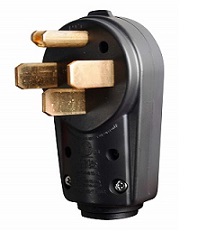
A 50-amp plug has four prongs (three flat and one U-shaped). Hot 1 and Hot 2 are on the sides, while the neutral is on the bottom. A U-shaped ground prong is on the top.
Hots give you 120 volts of electricity each and when added together, you get a total of 240 volts and this is how the outlet for 50-amp service looks like:
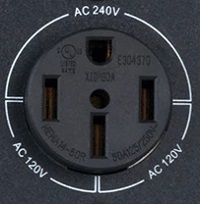
This type of service is commonly found in larger RVs with 2 A/C units on the roof. It is a 240/120 service that allows you to have 120-volt outlets along with 240-volt outlets for larger appliances.
30-amp RV service
30-amp RVs are often smaller and don’t use as much power as larger rigs. This is what the plug of the 30-amp service looks like (3-prongs):

A 30-amp plug has three prongs, two of which are flat and slightly slanted and one of which is round or U-shaped. The first slanted prong is connected to a hot wire, while the other serves as a neutral (or power return). The ground is represented by the U-shaped prong.
30-amp RV service runs on 120 volts and this is the outlet that you plug it into:

Types of power adaptors
There are three basic types of adaptors that you can use:
1. Dogbone adaptor
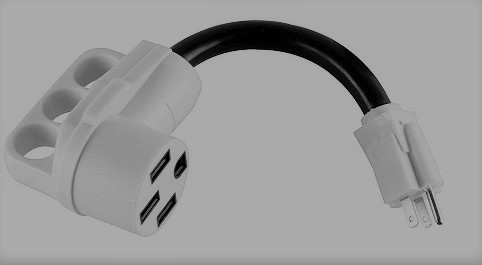
2. Straight plug

3. Split adaptor ( or Y adapter)
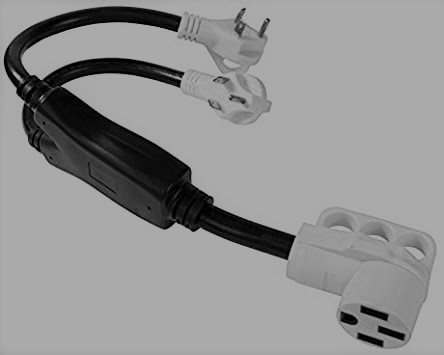
Sizes of power adaptors
Adaptors can offer you different types of connections (depending on what you have available). Believe it or not, you can almost get the whole 50-amps in some cases if you get creative…
50-amp to a 30-amp adaptor
The plug that you use to convert 50-amp service into 30-amp service looks like this (paid link):
This incredibly durable and also flexible adaptor (or dogbone) from RVGUARD (paid link) earned five stars on Amazon! It also comes with a finger grip and a led light to show you that it is working.
45-amp adapter (split)
You can also try another interesting device that can convert two circuits into 45-amps and give you:
45 amps x 120 volts = 5,400 watts
This device is called Heavy Duty PowerGrip Maximizer (paid link) and all you need is a 30-amp outlet and a 15-amp outlet. It will combine the power from both circuits and give you a nice adaptor for your 50-amp service:
Two 30-amp male adaptors
And there is also one with two 30-amp plugs. That is in case there is nobody parked on the other side of the pedestal or there are two 30-amp outlets available.
If you need to run your A/C, this unit can surely solve your problem. Here is a very popular model from LeisureCords (paid link):
Here is a nice overview of different types of adaptors available to RVers (everything you need in your power cord arsenal to enjoy your camping):
A heavy-duty extension cord is also important in some situations:
Voltage drop problem
Voltage drop can really become a problem if you use an extension cord. Try avoiding running long lines and several connectors (if possible).
In case you think you will really need an extension cord at some point, here is a good quality one from Camco that earned 5 stars from reviewers on Amazon (paid link):
If there will be Undervoltage due to using long cables and you have a good surge protector, just like this one from SurgeGuard (paid link), it will protect your RV by cutting down the power when the voltage falls below 102 volts:
If you don’t have a surge protector installed and the voltage dips too low, items like electronics and AC compressors will start to burn up. This can also result in melted wires and the plug itself.
Are these adapters safe to use?
A quality adaptor is a good investment considering that it will not melt, cause a short circuit and deliver the wrong amount of power to your equipment! They are usually made with heavy-duty flame retardant material which is also UV-resistant.
These electrical adaptors adhere to the highest possible electrical standards and stand behind their reputation.
They are maybe a little more expensive, but you are dealing with electricity here and really have to be careful…
When choosing the correct power adapter think about safety, efficiency, and your needs. Heavy-duty, weather-resistant adaptors will keep you from accidents like getting shocked, electrocuted, or burned by touching an overheated plug.
Before using your adaptor, make sure:
- Prongs are cleaned for good connection. You can use light sandpaper to accomplish that.
- Prongs are not bent or loose. You cannot really fix that and in this case, getting a new adaptor or extension cord is a good idea.
- The cord is NOT damaged in any way. If damage or cut to the cord is not too deep, you can repair the cord with electrical tape.
- All connections should be tight and secure. NEVER disconnect by pulling the cord! You have to pull on the PLUG for disconnecting the cord.
- If you are using extension cords, do NOT keep connections on the ground! They should NOT be in contact with moisture or water.
- The fewer adaptors you use, the better.
- Use surge protector with low-voltage shut OFF feature.
- Do NOT continue to use the adaptor if it gets too hot!
- If you have to use an extension cord, use the shortest one possible to avoid voltage drop or get a thicker wire.
Here are some wire ratings for you:
|
Wire Size |
Amp Rating |
| Gauge #14 | 15 amps |
| Gauge #12 | 20 amps |
| Gauge #10 | 30 amps |
| Gauge #8 | 40 amps |
| Gauge #6 | 55 amps |
When buying an adapter, you need to always watch for the following:
- It needs to be heavy-duty. Since the power will be drawn for a long time, flimsy cables and the adaptor itself can cause a lot of problems! The adaptor could melt, the wires could melt and cause a short circuit, anything flammable next to your hot adaptor could start a fire…
- It needs to be weather-resistant. Your adaptor will be exposed to the elements and you need protection. We all heard that: “Electricity and water don’t mix!”, right?
- LED power indicator lights are handy. This way you will know if electricity is flowing or not BEFORE you start testing your appliances out.
- Preferably with a finger grip or a handle. This way you don’t have to struggle connecting/disconnecting the adapter, which is less damaging on the cable as well.
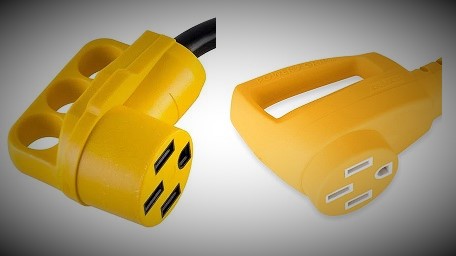
It is always a good idea to have a bunch of different adapters in your arsenal before you start traveling! You really never know where you are going to end up…
But this is what you like about this type of lifestyle, don’t you?


You can also search our database:
Attention! This article is for informational purposes ONLY and is NOT a replacement for professional advice! ALWAYS consult your local specialist for an appropriate solution to your problem. All statements, prices, contact information, recommendations, and reviews contained herein came from sources that we believe to be reliable, but the accuracy or completeness thereof is not guaranteed. Please contact the service provider for complete details and updates.







